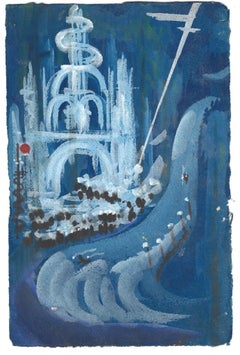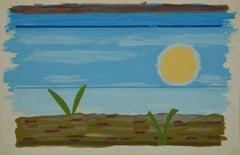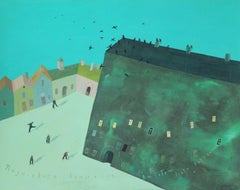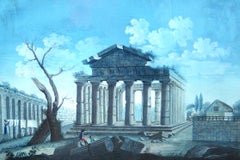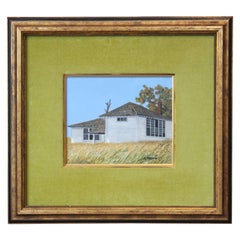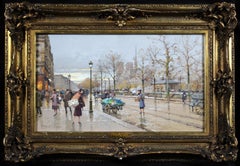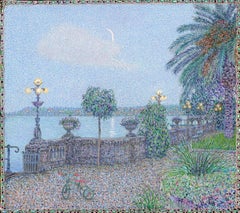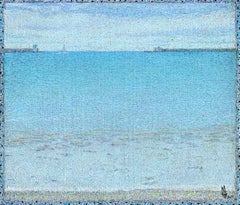Tempera Landscape Paintings
Color: Blue
Medium: Tempera
Night Fantasy - Original Tempera by Jean Raymond Delpech - 1960s
By Jean Delpech
Located in Roma, IT
Night Fantasy is an original tempera painting on cardboard, realized around 1960's by the French artist, Jean Raymond Delpech (1988-1916).
This...
Category
1960s Modern Tempera Landscape Paintings
Materials
Tempera
Landscape - Tempera - 1950
Located in Roma, IT
"Landscape" is an original painting in tempera and collage on cardboard, realized by Anonymous Artist of 20th Century.
In good conditions.
The artwork represents a summer landscape...
Category
1950s Modern Tempera Landscape Paintings
Materials
Cardboard, Tempera
The biggest house in town - Figurative Gouache Painting, Landscape, Architecture
Located in Warsaw, PL
PIOTR FĄFROWICZ (born in 1958). He studied art history at the Catholic University of Lublin. He deals with painting and graphic design. Winner of numerous awards for illustrations, i...
Category
21st Century and Contemporary Other Art Style Tempera Landscape Paintings
Materials
Paper, Tempera, Gouache
A Rise, blue and green casein on panel impressionist waterscape painting, 2004
By Alan Bray
Located in New York, NY
Bray has explored a smaller, more demure 8.5 x 11 inch format for two of these casein on panel paintings. When coupled with his rich palette and tightly hatched bed of brushstrokes, ...
Category
2010s American Impressionist Tempera Landscape Paintings
Materials
Casein
View of the Hexastyle Periptero Temple from the part of Ponente - Tempera
Located in Roma, IT
Original Title: Veduta del Tempio Esastilo Perittero dalla Parte di Ponente
Tempera painting on paper, cm 34x46.5, including coeval gilded frame, cm 42.7x1.6x54.3
Wonderful View of...
Category
Early 19th Century Tempera Landscape Paintings
Materials
Tempera
Related Items
Untitled Acrylic Architectural Landscape Painting
Located in Houston, TX
Architectural landscape painting by Anthony V. Martin of a white house with a lovely green velvet mat and a gold frame.
Artist Biography: Anthony V. Martin grew up in east Texas. H...
Category
1960s Modern Tempera Landscape Paintings
Materials
Egg Tempera
H 15 in W 16.5 in D 1.5 in
Le Quai de la Tournelle - Impressionist Cityscape Oil by Eugene Galien-Laloue
Located in Marlow, Buckinghamshire
Signed impressionist gouache on paper figures in landscape circa 1910 by French painter Eugene Galien-Laloue. The piece depicts a street scene at the Quai de la Tournelle...
Category
1910s Impressionist Tempera Landscape Paintings
Materials
Paper, Gouache
The Gateway
Located in New York, NY
Signed (lower right): ELEANOR PARKE CUSTIS
Category
20th Century American Realist Tempera Landscape Paintings
Materials
Paper, Gouache
Pikes Peak, 1940s Colorado Mountain Landscape in Autumn, Tempera Painting
Located in Denver, CO
Original vintage 1941 Colorado landscape painting with autumn leaves and Pikes Peak blanketed in snow by Charles Bunnell (1897-1968). Inscribed verso, "To Laura, November 22, 1941", egg tempera on board. Signed by the artist in the lower left corner and titled verso. Presented in a custom frame, outer dimensions measure 15 ½ x 19 ¼ x 1 ¼ inches. Image size is 7 ¾ x 11 inches
About the Artist:
Artist and teacher, Charles ("Charlie") Bunnell worked in a variety of styles throughout his career because as an artist he believed, "I’ve got to paint a thousand different ways. I don’t paint any one way." At different times he did representational landscapes while concurrently involved with semi- or completely abstract imagery. He was one of a relatively small number of artists in Colorado successfully incorporating into their work the new trends emanating from New York and Europe after World War II. During his lifetime he generally did not attract a great deal of critical attention from museums, critics and academia. However, he personally experienced a highpoint in his career when Katherine Kuh, curator at the Art Institute of Chicago, personally chose one of his paintings - Why? - for its large exhibition of several hundred examples of abstract and surrealist art held in 1947-48, subsequently including it among the fifty pieces selected for a traveling show to ten other American museums.
An only child, Bunnell developed his love of art at a young age through frequent drawing and political cartooning. In high school he was interested in baseball and golf and also was the tennis champion for Westport High School in Kansas City. Following graduation, his father moved the family to Denver, Colorado, in 1916 for a better-paying bookkeeping job, before relocating the following year to Colorado Springs to work for local businessman, Edmond C. van Diest, President of the Western Public Service Company and the Colorado Concrete Company. Bunnell would spend almost all of his adult life in Colorado Springs.
In 1918 he enlisted in the United States Army, serving in the 62nd Infantry Regiment through the end of World War I. Returning home with a 10% disability, he joined the Zebulon Pike Post No. 1 of the Disabled American Veterans Association and in 1921 used the benefits from his disability to attend a class in commercial art design conducted under a government program in Colorado Springs. The following year he transferred to the Broadmoor Art Academy (founded in 1919) where he studied with William Potter and in 1923 with Birger Sandzén. Sandzén’s influence is reflected in Bunnell’s untitled Colorado landscape (1925) with a bright blue-rose palette.
For several years thereafter Bunnell worked independently until returning to the Broadmoor Art Academy to study in 1927-28 with Ernest Lawson, who previously taught at the Kansas City Art Institute where Bunnell himself later taught in the summers of 1929-1930 and in 1940-41. Lawson, a landscapist and colorist, was known for his early twentieth-century connection with "The Eight" in New York, a group of forward-looking painters including Robert Henri and John Sloan whose subject matter combined a modernist style with urban-based realism. Bunnell, who won first-place awards in Lawson’s landscapes classes at the Academy, was promoted to his assistant instructor for the figure classes in the 1928-29 winter term. Lawson, who painted in what New York critic James Huneker termed a "crushed jewel" technique, enjoyed additional recognition as a member of the Committee on Foreign Exhibits that helped organize the landmark New York Armory Exhibition in 1913 in which Lawson showed and which introduced European avant-garde art to the American public.
As noted in his 1964 interview for the Archives of American Art in Washington, DC, Bunnell learned the most about his teacher’s use of color by talking with him about it over Scotch as his assistant instructor. "Believe me," Bunnell later said, "[Ernie] knew color, one of the few Americans that did." His association with Lawson resulted in local scenes of Pikes Peak, Eleven Mile Canyon, the Gold Cycle Mine near Colorado City and other similar sites, employing built up pigments that allowed the surfaces of his canvases to shimmer with color and light. (Eleven Mile Canyon was shown in the annual juried show at the Carnegie Institute in Pittsburgh in 1928, an early recognition of his talent outside of Colorado.) At the same time, he animated his scenes of Colorado Springs locales by defining the image shapes with color and line as demonstrated in Contrasts (1929). Included in the Midwestern Artists’ Exhibition in Kansas City in 1929, it earned him the gold medal of the Kansas City Art Institute, auguring his career as a professional artist.
In the 1930s Bunnell used the oil, watercolor and lithography media to create a mini-genre of Colorado’s old mining towns and mills, subject matter spurned by many local artists at the time in favor of grand mountain scenery. In contrast to his earlier images, these newer ones - both daytime and nocturnal -- such as Blue Bird Mine essentially are form studies. The conical, square and rectangular shapes of the buildings and other structures are placed in the stark, undulating terrain of the mountains and valleys devoid of any vegetation or human presence. In the mid-1930s he also used the same approach in his monochromatic lithographs titled Evolution, Late Evening, K.C. (Kansas City) and The Mill, continuing it into the next decade with his oil painting, Pikes Peak (1942).
During the early 1930s he studied for a time with Boardman Robinson, director of the Broadmoor Art Academy and its successor institution, the Colorado Springs Fine Arts Center from 1930 to 1947. In 1934 Robinson gave him the mural commission under the Public Works of Art Project (PWAP) for West Junior High School in Colorado Springs, his first involvement in one of several New Deal art...
Category
1930s American Impressionist Tempera Landscape Paintings
Materials
Egg Tempera, Board
H 15.5 in W 19.25 in D 1.25 in
A Gaucho and His Horse - Gouache On Paper Brazilian Cowboy on the Plains
Located in Soquel, CA
A Cowboy And His Horse - Gouache On Paper
Gouache on paper painting depicting a cowboy and his horse by a campfire by Reinaldo Manzke (Brazilian, 1906-1980). A cowboy is seen sittin...
Category
Mid-20th Century Impressionist Tempera Landscape Paintings
Materials
Paper, Gouache
landscape with bell tower oil on cardboard painting spain
Located in Barcelona, Barcelona
Joan Joseph Garí (1922) - landscape with bell tower - Oil on cardboard
Oil measures 33x45 cm.
Frame siza 46x59 cm.
Painter born in Granollers in 1922. Trained in his hometown and at...
Category
1970s Post-Impressionist Tempera Landscape Paintings
Materials
Oil, Cardboard
No Reserve
H 13 in W 17.72 in
Springtime, 1960s Semi Abstract Modernist Mountain Landscape Tempera Painting
Located in Denver, CO
"Springtime" is an original tempera on board painting of a Colorado mountain landscape painting by Ethel Magafan circa 1960. Abstracted mountain landscape with trees, painted in colors of green, purple, golden yellow, red, orange, blue, black and white. Presented in a custom hardwood frame, outer dimensions measure 23 ¼ x 50 x 2 inches. Image size is 30 x 48 inches.
Provenance: Private collection, Maine
Acquired in the early 1960s, by descent through the family to the present owner
About the Artist:
Jenne and Ethel Magafan were identical twins, born in Chicago to a Greek immigrant father and a Polish mother. Due to health concerns about their father, the family moved to Colorado, living first in Colorado Springs and then in Denver. He was a proud supporter of their artistic ambitions but died suddenly 1932, a heavy blow to both of them. They attended East High School in Denver, where they found a mentor in their art teacher Helen Perry. She had studied at the Art Institute of Chicago but had later abandoned a career as an artist, making her all the more determined to help the Magafan twins succeed artistically.
While still in high school, the twins impressed artist Frank Mechau, and Helen Perry paid for their lessons with him. He subsequently invited them to apprentice with him at his Redstone studio. In 1936, Jenne won the Carter Memorial Art Scholarship and shared it with her sister so that they both could attend the Broadmoor Art Academy in Colorado Springs. Once they ran out of money, Mechau, now teaching there, hired them as assistants. Through their involvement at the Academy, the twins entered into careers as muralists, working at first with Mechau and then with Peppino Mangravite.
From 1937 to 1943, Ethel was commissioned to paint her first of seven government sponsored murals. Located in the US Post Office in Auburn, Nebraska, this commission made Ethel (at age 26) the youngest artist in America to receive such an honor. Denver Art Museum director Donald J. Bear once commented that “[Ethel and Jenne's] study of local detail makes them appear as little Bruegels of ranch genre – natural and unforced.”
As mural painting commissions diminished, Ethel began to do more easel painting for which she used a palette knife and tempera paints to great effect. After settling in California for five years, the twins permanently relocated to Woodstock, New York in 1945, where the sisters lived apart for the first time. Ethel developed an increasing focus within her work, particularly for horses and abstract landscapes. She met fellow artist Bruce Currie...
Category
Mid-20th Century American Impressionist Tempera Landscape Paintings
Materials
Tempera, Board
Spring Storm, Modernist Southwestern New Mexico Landscape Casein Painting
By Doel Reed
Located in Denver, CO
Spring Storm, original vintage painting by New Mexico & Oklahoma modernist, Doel Reed (1894-1985). Evening scene with hint of a moon, clouds and rain over a rocky western landscape with low mountains/buttes, dated, June 1980 and signed by the artist lower right. Presented in a custom frame, outer dimensions measure 24 ½ x 37 ½ x 1 ¼ inches. Image size is 14 ¾ x 27 ¾ inches.
Provenance: Private Collection, Denver, Colorado
Expedited and international shipping is available - please contact us for a quote.
About the Artist:
Early in his artistic career, Doel Reed knew he wanted to be a printmaker. Influenced by Goya's aquatints, he extended himself beyond his formal art training to learn this technique, and he established himself as one of its masters. For decades, he devoted himself to the art program at the University of Oklahoma, taking it from a faculty of one to a major mid-Western department. Upon retirement, Reed focused totally on his work, moving with his family to Taos, New Mexico, where they had previously summered. Marked by strong tonal contrasts, his landscapes of this region are deeply emotional renderings with a sense of mystery -- modernist forms combined with romantic moodiness.
Born and raised in Indiana, Reed originally studied architecture, which he credits with a lifelong attention to "how something is constructed." His mature style can be characterized as architectonic in his concern with assembling volumes and planes. Even the intense northern New Mexico light becomes the means to articulate three-dimensional patterns into cubistic interplay. When painting, Reed used thick strokes of oil and casein as another structural element.
Transferring to fine art, his studies at the Cincinnati Art Academy were then interrupted by military service in World War I. Suffering a gas attack in the trenches of France, Reed spent months in a hospital temporarily blinded. The effects of the gas also damaged his lungs, which later prompted him to live in the dry climates of Oklahoma and New Mexico.
After the war, he returned to his studies, but it was discovery of Goya's aquatints rather than his art classes that inspired. Considered the master, Goya drew on the tonal range available with this medium to create powerfully haunting imagery. Perhaps Reed responded personally to the eloquent series "The Disasters of War." Now his course was set, and he built his own etching press, which he continued to use for the rest of his life.
In 1924, he accepted a teaching position at Oklahoma State University, where he remained for thirty-five years. Emphasizing drawing, Reed encouraged students to go to nature and translate the scene through their own sensibilities. Beginning as the sole art professor, he developed the program when it became an independent department in 1930. Through his stewardship, the university gained a reputation as one of the best for printmaking in the country. During the forties, Reed also prepared a series of lectures and demonstrations on aquatint for the Association of American Colleges. His most public offering in art education is the book "Doel Reed Makes An Aquatint" (1965).
Sabbaticals allowed him to visit Paris in 1926 and 1930-31. Summer travel took him to Nova Scotia and Mexico, but gas rationing during World War II necessitated a closer destination. Thus the Reed connection with Taos was established. Finally in 1959, he, his wife, and daughter moved there to Talpa Ridge, the same outlying area in which artists like Andrew Dasburg, Howard Cook, and Barbara Latham resided. Settling into a complex of three adobe buildings, Reed was welcomed by these artists, who referred to their community as Neurosis Ridge. Rena Rosenquist of Mission Gallery remembers that Reed was "the most affable man" who liked cold martinis.
For Reed, the surrounding Sangre de Cristo Mountains offered "end of abstract pattern." His inventive mind came up with techniques to transform a natural scene into a richly dimensional object. He fashioned a rosin box and concocted his own formula of etching ground to achieve a velvety texture with his prints. Described as "not for the faint-hearted,”" casein became a medium with which built up paint surfaces that almost seem sculpted. Both the prints and drawings are characterized by a tension between the two-dimensional surface pattern and the articulated space it conveys.
In addition to landscapes, Reed produced a number of works of voluptuous women with the figures echoing landscape elements. As a boy, his first art experience was a grade-school field trip to the John Herron Art Museum (now the Indianapolis Art Museum), where he expressed his admiration for a painting of a nude mermaid -- an image that made a lasting impression.
Reed was proudest of his recognition by the National Academy of Design (now just the National Academy). In 1942, he was named associate member; in 1952, he was named full academician. ©David Cook Galleries, LLC
Exhibited: Society of Independent Artists, 1927 & 1929; Society of American Etchers, 1930-1946; Kansas City Art Institute, 1932; “100 Etchings of Year,” 1932-44; Art Institute of Chicago, 1934, 1937, 1939; National Academy of Design, 1934-46, 1965 (Samuel Morse Medal); Tulsa Art Association, 1935 (prize); Paris Salon, 1937; Rome, Italy, 1937; Sweden, 1938; Chicago Society of Etchers, 1938 (prize); Corcoran Gallery of Art, Washington, D.C., 1940; Philadelphia Print Club, 1940 (prize); Venice, Italy, 1940; Carnegie Institute, 1941; Currier Gallery of Art, Manchester, NH,1942, (prize); Metropolitan Museum of Art, 1942; Whitney Museum of American Art, 1942; Northwest
Printmakers, 1942 (prize), 1944 (prize); Herron Art Institute, 1943; Library of Congress, 1944-46; Pennsylvania Academy of the Fine Arts, 1944-45; Philbrook Art Club, 1944 (prize); Laguna Beach Art Association, 1944 (prize); Southern States Art League, 1944 (prize); “50 American Prints,” 1944; Oakland Art Gallery, 1945 (prize); Audubon Artists, 1945, 1951 (Gold Medal of Honor), 1954 (John Taylor Arms Memorial Medal); Albany Institute of History and Art, 1945; Pasadena Art Institute, 1946; London; Allied Art Association; National Society of Painters Casein; Mission Gallery, Taos, NM, and Blair Galleries, Ltd. Santa Fe, NM.
Works Held: Carnegie Institute; Honolulu Academy of Art; Grinnell College; Library of Congress; Metropolitan Museum of Art; Museum of Fine Art, Houston; New York Public Library; Oklahoma Art Club; Pennsylvania Academy of Fine Art; Philadelphia Museum of Art; Philbrook Art Club; Seattle Art Museum; Southern Methodist University; University of Montana; University of Tulsa; Bibliotéque Nationale, Paris; Victoria and Albert Museum, London.
Further Reading: Harmsen's Western Americana: A Collection of One-Hundred Western Paintings with Biographical Profiles of the Artists, Dorothy Harmsen, Northland Press, Flagstaff, Arizona, 1971.; The Illustrated Biographical Encyclopedia of Artists of the American West, Peggy and Harold Samuels, Doubleday & Company, Inc., Garden City, New York, 1976.; Taos Artists...
Category
1980s American Modern Tempera Landscape Paintings
Materials
Casein, Archival Paper
H 24.5 in W 37.5 in D 1.25 in
Americans Modernist Tempera Painting, Penguins in Snowy Landscape, Blue White
Located in Denver, CO
Original American Modernist tempera painting on masonite by Archie Musick (1902-1978). Signed by the artist in the lower right corner. Depicted is a landscape with penguins marching ...
Category
Mid-20th Century American Modern Tempera Landscape Paintings
Materials
Tempera, Masonite
H 10.5 in W 20.5 in D 0.75 in
The Visit of the English Squadron to Le Havre
By Raoul Dufy
Located in New Orleans, LA
Raoul Dufy
1877-1953 | French
The Visit of the English Squadron to Le Havre
Signed "Raoul Dufy" (lower center)
Watercolor and gouache on paper
Growing up along the coastline of th...
Category
Early 20th Century Post-Impressionist Tempera Landscape Paintings
Materials
Watercolor, Gouache, Archival Paper
Central Park, Winter
Located in New York, NY
Signed lower left: Guy Wiggins / Guy Wiggins; on verso (photo available): CENTRAL PARK. WINTER. / GUY WIGGINS N.A. / 1936.
Category
Mid-20th Century American Impressionist Tempera Landscape Paintings
Materials
Canvas, Oil
Taxco, Mexico - 1930's Figurative Village Landscape
Located in Soquel, CA
A vintage watercolor capturing a daily scene in the Spanish colonial town of Taxco, Mexico by Theodore Ernest Langguth (German-American, 1861-1952). Titled, dated and signed lower ma...
Category
1930s American Impressionist Tempera Landscape Paintings
Materials
Paper, Watercolor, Gouache, Pencil
H 16.75 in W 13.88 in D 1 in
Previously Available Items
"Evening.Villa Maria au Lac." Painting by Nikita Makarov
Located in Culver City, CA
"Evening.Villa Maria au Lac." Painting by Nikita Makarov
Woodpanel, levkas, tempera, acrylic
2021
Comes in a custom frame as shown on photos.
Frames a...
Category
21st Century and Contemporary Pointillist Tempera Landscape Paintings
Materials
Acrylic, Tempera, Wood Panel
"Coast.Saint-Jean-de-Luz" Painting by Nikita Makarov
Located in Culver City, CA
"Coast.Saint-Jean-de-Luz" Painting by Nikita Makarov
Woodpanel, levkas, tempera, acrylic
2020
Comes in a custom frame as shown on photos.
Frames are designed by the Artist for each...
Category
21st Century and Contemporary Pointillist Tempera Landscape Paintings
Materials
Acrylic, Tempera, Wood Panel
"Night.Villa Maria Au Lac" Painting by Nikita Makarov
Located in Culver City, CA
"Night.Villa Maria Au Lac" Painting by Nikita Makarov
Woodpanel, levkas, tempera, acrylic
2020
Comes in a custom frame as shown on photos.
Frames are designed by the Artist for eac...
Category
21st Century and Contemporary Pointillist Tempera Landscape Paintings
Materials
Acrylic, Tempera, Wood Panel
"La Corricella.Procida." Painting 8" x 8" inch by Nikita Makarov
Located in Culver City, CA
"La Corricella.Procida." Painting 8" x 8" inch by Nikita Makarov
Woodpanel, levkas, tempera, acrylic
2020
Comes in a custom frame as shown on photos.
Frames are designed by the Artist for each work.
Size: 8" x 8" inch
Size framed: 16" x 17" inch
Makarov is attracted to the discreet beauty of the world – not the wild scenery, but a lived-in space, where urban culture permeates nature. His landscapes, whether a deserted European beach subsumed in the evening twilight...
Category
21st Century and Contemporary Pointillist Tempera Landscape Paintings
Materials
Acrylic, Tempera, Wood Panel
"Heat. Methoni" Framed: 19" x 20" inch Painting by Nikita Makarov
Located in Culver City, CA
"Heat. Methoni" Framed: 19" x 20" inch Painting by Nikita Makarov
Woodpanel, levkas, tempera, acrylic
2016
Comes in a custom frame as shown on photos.
Size framed: 19" x 20" inch
...
Category
21st Century and Contemporary Pointillist Tempera Landscape Paintings
Materials
Acrylic, Tempera, Wood Panel
"Daytime breeze.Villa Maria Au Lac" Framed 20"x23" in Painting by Nikita Makarov
Located in Culver City, CA
"Daytime breeze.Villa Maria Au Lac" Framed 20"x23" in Painting by Nikita Makarov
Woodpanel, levkas, tempera, acrylic
2019
Comes in a custom frame as shown on photos.
Size framed: 2...
Category
21st Century and Contemporary Pointillist Tempera Landscape Paintings
Materials
Acrylic, Tempera, Wood Panel
Winter - XXI Century, Contemporary Figurative Gouache Painting, Landscape
Located in Warsaw, PL
PIOTR FĄFROWICZ (born in 1958). He studied art history at the Catholic University of Lublin. He deals with painting and graphic design. Winner of numer...
Category
21st Century and Contemporary Tempera Landscape Paintings
Materials
Paper, Tempera, Gouache
Winter. A window - XXI Century, Landscape Gouache Painting, Blue, Winter Scene
Located in Warsaw, PL
PIOTR FĄFROWICZ (born in 1958). He studied art history at the Catholic University of Lublin. He deals with painting and graphic design. Winner of numerous awards for illustrations, i...
Category
21st Century and Contemporary Other Art Style Tempera Landscape Paintings
Materials
Paper, Tempera, Gouache
Blue Marine - Original Tempera on Paper by Jacques Meunier - Mid 20th Century
By Jacques Meunier
Located in Roma, IT
Blue Marine is an original artwork realized by Jacques Meunier. Original tempera on paper.
Hand-signed by the artist on the lower right corner.
The artwork is sketched and drawed o...
Category
Mid-20th Century Tempera Landscape Paintings
Materials
Tempera
H 7.09 in W 10.44 in D 0.04 in
"Montauk Rose"
By Wynn Chamberlain
Located in Southampton, NY
Wynn Chamberlain was once described by the New York Times as a "pioneer realist painter. He was a American artist, film marker and author.
Mr. Cha...
Category
1950s American Realist Tempera Landscape Paintings
Materials
Egg Tempera
Tempera landscape paintings for sale on 1stDibs.
Find a wide variety of authentic Tempera landscape paintings available on 1stDibs. While artists have worked in this medium across a range of time periods, art made with this material during the 21st Century is especially popular. If you’re looking to add landscape paintings created with this material to introduce a provocative pop of color and texture to an otherwise neutral space in your home, the works available on 1stDibs include elements of blue, orange, purple, green and other colors. There are many well-known artists whose body of work includes ceramic sculptures. Popular artists on 1stDibs associated with pieces like this include Paolo Buggiani, Charlotte Sternberg, John Atherton, and Alan Bray. Frequently made by artists working in the Modern, Impressionist, all of these pieces for sale are unique and many will draw the attention of guests in your home. Not every interior allows for large Tempera landscape paintings, so small editions measuring 0.1 inches across are also available
Recently Viewed
View AllMore Ways To Browse
Winter Scene Painting 1930
Jules Breton
Davenport Vintage
French Bat
Middle Eastern Landscape
Swedish Midcentury Landscapes
Retro Horse Illustration
Shell Sign Oil
Shell Oil Sign
White Hart
Boat Painting Impressionist Large
Moonlit Landscape
Garage Signs
River Landscape With Cottage
Western Cloud Landscape
Mississippi River Art
Japanese Pond
St James Park
